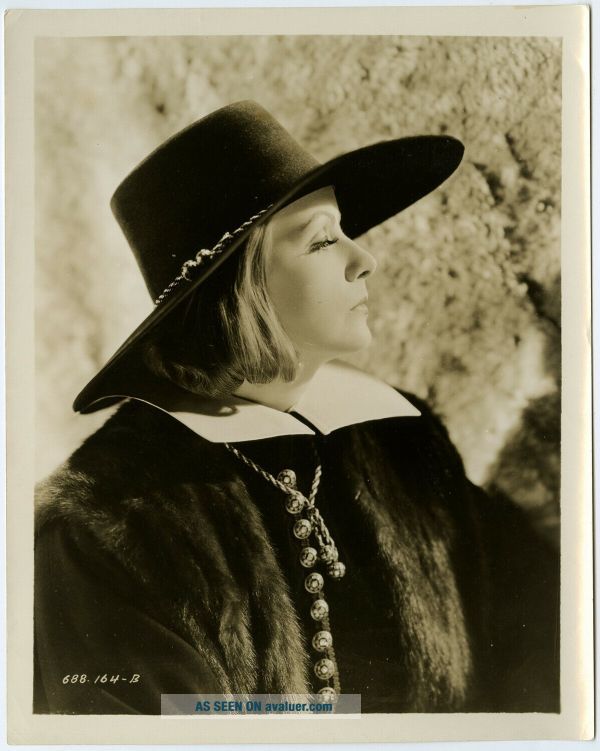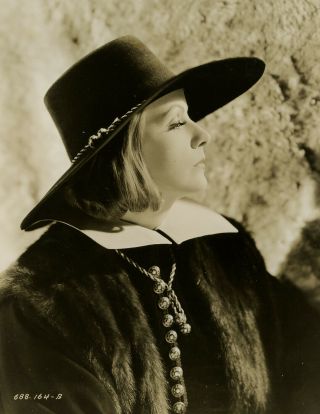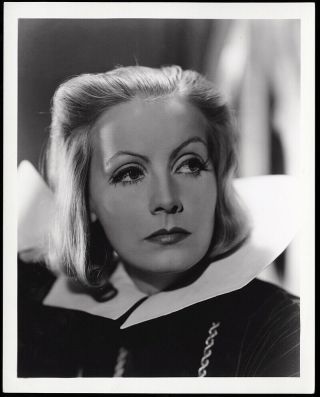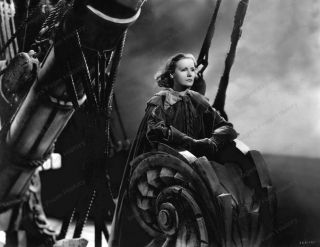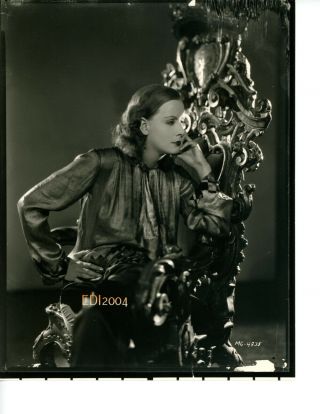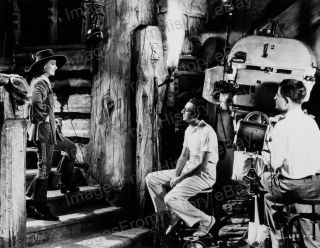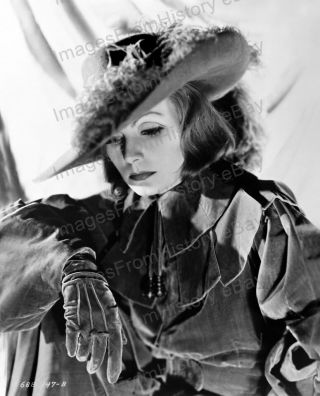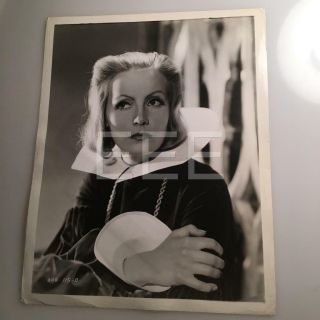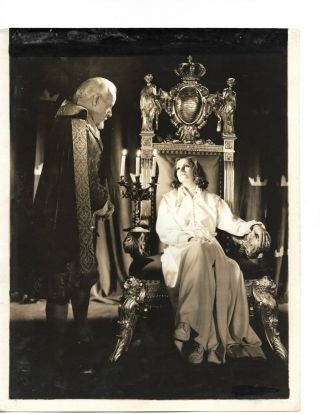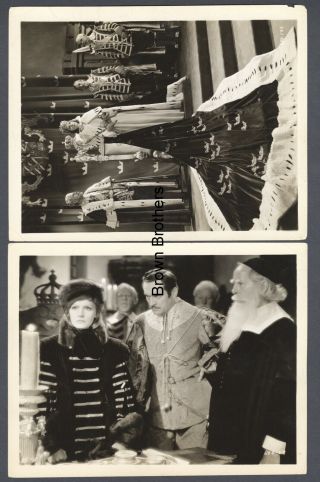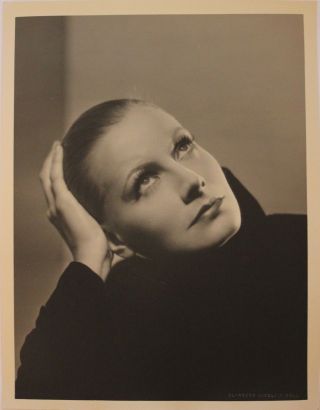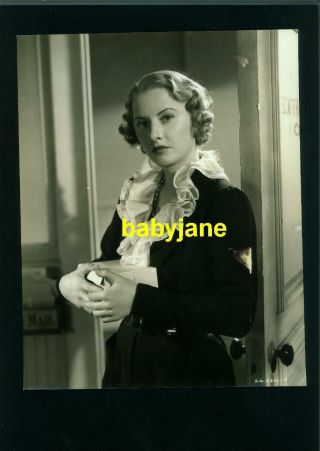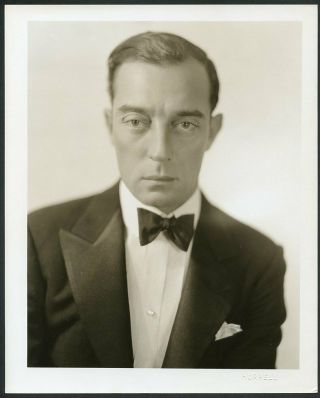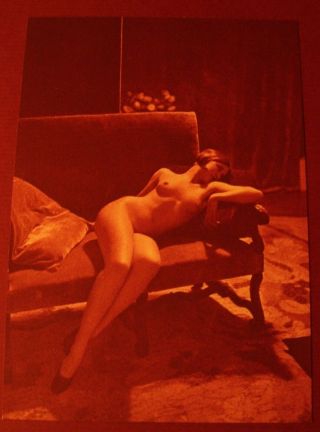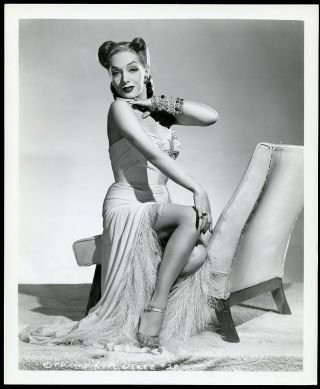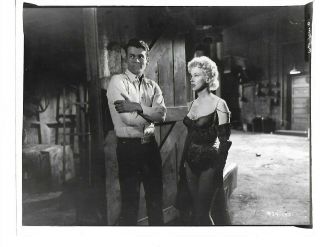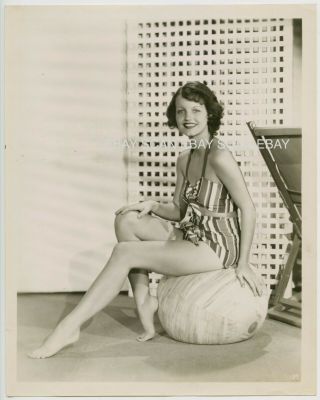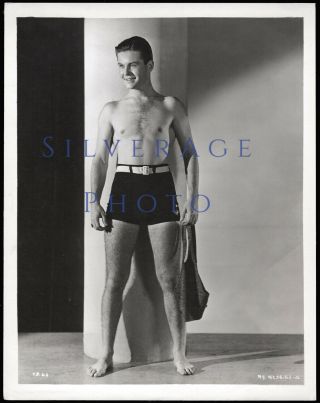Greta Garbo Queen Christina 1933 Vintage Photograph Clarence Sinclair Bull Rare
Item History & Price
Photograph measures 8" x 10" on a glossy single weight paper stock.
Guaranteed to be 100% vintage and original from Grapefruit Moon Gallery.
More about Greta Garbo:
Greta Garbo was arguably the quintessential embodiment of Hollywood’s Golden Age, a beautiful, glamorous, and above all, ...mysterious image, carefully cultivated by Metro-Goldwyn-Mayer, the sole studio she would work for during her American film career. Touted as the "Swedish Sphinx" by MGM upon her arrival in Hollywood, Garbo immediately became one of silent film’s most popular actresses in such features as "The Torrent" (1926), "Flesh and the Devil" (1927) and "Love" (1927). Paired with the most talented directors and popular leading men, she entranced audiences with her mesmerizing portrayals of "fallen women" and fatalistic lovers. Even the arrival of sound could not diminish her appeal; in fact, Garbo’s sultry, accented voice only added to her allure in her first "talkie, " "Anna Christie" (1930). Later films – in particular, "Mata Hari" (1931), "Grand Hotel" (1932), "Queen Christina" (1933) and "Camille" (1936) – cemented her megastar status, not only in America, but around the world. Known for her aversion to publicity and demanding nature on the set of her films, she was also an astute business woman, whose bargaining acumen made her one of the highest paid movie stars of the day. Garbo's sudden decision to retire from film in 1941 and her steadfast maintenance of a notoriously reclusive lifestyle until her death in 1990 further enhanced her mystique and immortalized her as one of the silver screen’s greatest icons.
Born Greta Lovisa Gustafsson on Sept. 18, 1905 in Stockholm, Sweden, she was the youngest child of Anna Lovisa and Karl Alfred Gustafsson. Karl was an unskilled laborer, who took on any menial job he could; consequently, Garbo’s childhood was one of near abject poverty. Life was made even more difficult for the shy girl when her father grew seriously ill and she was forced to leave school at the age of 13 to care for him. Karl passed away a year later, inevitably leading to the 14-year-old Garbo entering the workforce to help support the family – first in a barbershop and later as a department store salesclerk. It was while working at the latter job in 1921, that the attractive young clerk – who had already begun working as a catalogue model – was cast in a short advertisement film sponsored by the store. This led to more promotional shorts and a role in the silent comedy feature "Luffar-Petter" ("Peter the Tramp") (1922). Enamored by the theater since she was a child, Garbo studied for two years at Stockholm’s Royal Dramatic Theatre Acting School, during which time she was chosen by noted Swedish film director Mauritz Stiller to play the lead in the romantic drama "Gösta Berlings Saga" ("The Saga of Gosta Berling") (1924). Stiller soon became her mentor and manager, controlling all aspects of her emerging career, including changing her surname to "Garbo."
The newly christened Garbo may not have taken her homeland by storm, but in Germany, where she was seen in her second feature, the G.W. Pabst-directed drama "The Joyless Street" (1925), they loved her. Accounts of what brought Garbo to America differ – some said it was Stiller, who insisted his young protégé join him; others that media mogul Louis B. Mayer was immediately taken by her screen presence. Regardless of the particulars, in the summer of 1925, both Stiller and Garbo left Sweden for Hollywood with contracts awaiting them at MGM. She first appeared in two Latin love stories drawn from torrid Vicente Blasco-Ibanez novels. First came "The Torrent" (1926), in which an unconvinced MGM cast her as a vamp opposite leading man Ricardo Cortez. For her part, Garbo was unimpressed by the script and disappointed that Stiller would not be directing her in her U.S. film debut. MGM, on the other hand, was thrilled by the film’s eventual box-office success and the critical raves Garbo received for her performance. Always looking for a winning formula, the studio immediately cast her in a similar vehicle, opposite Latin heartthrob Antonio Moreno in "The Temptress" (1926). This time, however, the actress was given top billing and was to be directed by Stiller, who had convinced Garbo to accept the project. The experience was not a happy one, though, as the confrontational Stiller was quickly fired from the film and Garbo received word of her sister’s death in Sweden during the shoot. Nonetheless, "The Temptress" was a hit with moviegoers and MGM had officially found its newest star.
Garbo’s major breakthrough came with her third feature when MGM paired her with the silent screen's most popular leading man, John Gilbert, in the unrestrained romance "Flesh and the Devil" (1927). By all accounts, the two developed an instant and intense romantic rapport that carried over onscreen and encouraged the publicity and gossip about her offscreen life that followed Garbo throughout the remainder of her life. Following the undeniable success of "Flesh and the Devil, " Garbo – already exhausted from her hectic schedule and still angry over the studio’s refusal to allow her to attend her sister’s funeral in Sweden – demanded a raise. Initially, MGM balked, but after shrewd negotiation tactics that included threats to return to Sweden and a temporary strike, Garbo’s pay increased to record levels, and her cavalier indifference to stardom served only to fuel her legend even more. During the remainder of her career at MGM, Garbo would work with only the most venerated directors, most notably Clarence Brown, with whom she collaborated on a total of seven films. The superstar was also given her preference in production staff, often working with her favorite cinematographer, William Daniels. The studio also famously conceded to Garbo’s demands as to working conditions, which included closed sets, no overtime, and that she and the camera be entirely surrounded by black curtains during the filming of close-ups. Within three years of her arrival at MGM, Garbo's public image had been fashioned into the epitome of the glamorous excess the studio had become known for.
Garbo went on to film seven more silent films for MGM, all of which proved to be hugely successful. "Love" (1927) cast her opposite Gilbert once again in an adaptation of Leo Tolstoy’s Anna Karenina, and the studio shrewdly capitalized on the couple’s much publicized romance with its sensational marketing campaign. The advent of sound to motion pictures had proved to be the demise of so many Hollywood film actors, especially those transplanted from Europe, and an anxious MGM kept the thickly-accented Garbo away from the microphones for as long as possible. The actress’ final silent film, "The Kiss" (1929), would also be the studio’s last. Heralded by the famous ad campaign of "Garbo Talks!" the studio finally permitted the last of its silent stars to speak onscreen in the Brown-directed adaptation of Eugene O'Neill's "Anna Christie" (1930). MGM need not have worried, as American audiences were instantly beguiled by Garbo’s husky voice from the moment she uttered her first line – "Gimme a visky with a ginger ale on the side and don’t be stingy, baby." "Anna Christie" went on to become a massive hit – so successful, in fact, that a German language version was released the following year – and earned the actress her first Academy Award nomination. Re-teamed with Brown, she garnered another Oscar nod for her work in the "fallen woman" romantic drama "Romance" (1931). More popular releases followed in quick succession, including a smoldering turn as the titular World War I seductress "Mata Hari" (1931) in MGM’s biggest blockbuster of the year.
"Garbo-mania" reached its greatest height with the release of the star-studded ensemble drama "Grand Hotel" (1932), co-starring film royalty John and Lionel Barrymore, Joan Crawford and Wallace Beery. It was, however, Garbo’s fading ballerina character with her immortal, persona-defining declaration of "I want to be alone, " that stole the show. Directed by Edmund Goulding, "Grand Hotel" won the 1932 Academy Award for Best Picture. The success of "Grand Hotel" gave Garbo even more power within the studio, which she used to help her former lover, Gilbert, whose career had been suffering terribly since the introduction sound. The former superstar couple appeared onscreen one last time in the historical drama "Queen Christina" (1933), in which she gave one of her most revered performances as the 17th Century Swedish monarch. Garbo’s enigmatic, lengthy close up in the final seconds of the film would become one of cinema’s most examined screen moments. She then reprised her earlier acclaimed role in a more literal adaptation of "Anna Karenina" (1935), and continued with more portrayals of lonely women willing to sacrifice love for the greater good in "Camille" (1936) and "Conquest" (1937). While "Camille" earned her yet another Academy Award nomination, "Conquest, " due in large part to its monumental budget, became one of the star’s only box-office disappointments.
After having made a career playing doomed lovers in nearly two dozen tragic romantic dramas for MGM – and perhaps still stinging from the failure of "Conquest" – Garbo switched to comedy late in the game with "Ninotchka" (1939). Co-written by the great Billy Wilder and directed by Ernst Lubitsch, the movie was a delightful satire skewering Stalin-era Russia and introduced audiences to a previously unseen side of the actress with the marketing tagline "Garbo Laughs!" For her surprisingly versatile performance in the film, she received her fourth and final Academy Award nomination. Unfortunately, an attempt to continue the trend and present Garbo as a domesticated American housewife in director George Cukor's superficial farce "Two-Faced Woman" (1941), failed to attract audiences. With her much-needed international box office draw halted by the start of World War II and her domestic appeal on the wane, Garbo’s once undeniable bargaining had lost much of its power. When MGM stood firm in its refusal to once again increase her salary, the film legend left Hollywood in a retirement that was as sudden as it was permanent. Although enticed by filmmakers to return to the screen many times over the years, Garbo would never make another motion picture. Instead, she led a life of simplicity, indulgence and relative seclusion, traveling extensively throughout Europe while maintaining an upscale residence in Manhattan. Much as she had during her career, Garbo assiduously shunned publicity throughout her later years, only glimpsed infrequently by "Garbo watchers" during her occasional walks around her New York neighborhood. On April 15, 1990, Greta Garbo died at the age of 84 due to complications of pneumonia and kidney failure.
Biography From: TCM | Turner Classic Movies
More about Clarence Sinclair Bull:
What is there to say about the legendary Hollywood photographer Clarence Sinclair Bull that has not already been said?
One of the most well known and--along with George Hurrell--one said to have helped invent the modern idea of Hollywood Glamour in photography. Bull was born in Sun River, Montana (some sources say he was born in Michigan) in 1896. For a time he studied with the great Western painter Charles Marion Russell. But his real interest lie in photography.
He went to Hollywood in 1918 and became an assistant cameraman for Metro Pictures. During breaks from film production, he began taking photographs of the various stars of the time. In 1924, when Metro Pictures became Metro Goldwyn Mayer, Bull became head of MGM stills department. He remained with the studio until the end of his career.
Bull was very well accomplished in everything to do with his specialty from lighting to printing and retouching. He photographed many of the first-rate stars of the day including Elizabeth Taylor, Clark Gable, Joan Crawford, Leslie Howard, Katherine Hepburn, Gary Cooper, Hedy Lamarr, Vivian Leigh, Spencer Tracy, Ava Gardner, Grace Kelly, Jean Harlow, John Gilbert, among many others. Of course, he is extremely well known for his numerous photographs of Greta Garbo.
Katherine Hepburn said of Bull: "One of the greats. Clarence Bull! And the National Portait Gallery! WOW!"
From the book, 'Glamour of the Gods':
Clarence Sinclair Bull's long association as a photographer with the studio that would become Metro-Goldwyn-Mayer began when producer Samuel Goldwyn hired him in 1919. Managing to survive the commotion of the consolidation of Hollywood in the early and mid-1920s, Bull found himself at the helm of MGM's stills department when the studio was formed in 1924, and stayed there until retiring in 1961. The enormity of MGM's output of films in the 1920s--they advertiesed a new feature every week--saw Bull's domain grow. He was responsible for managing MGM's staff of photographers and the large support crew of technicians needed to develop, re-touch, print and collate the hundreds of thousands of prints distributed annually by MGM's publicity department. At least one photograph from the 1920s shows Bull with twelve stillsmen who juggled the task of shooting photos on as many as a dozen films that might be concurrently in production. At MGM, like the other studios, these men--and it was an almost exclusively male profession--worked six days a week and often long hours each day. Generally one photographer was assigned to a production and, as filming was underway, he would document each scene using an 8 x 10 view camera. These cameras not only had lenses with sharp resolution, but contact prints could be made from the negatives quickly and in enormous quantities. The stills made for each film were numbered sequentially and gathered together for a book. Stills photographers also created the images used for poster art, lobby cards and other forms of advertising conceived by imaginative publicity chiefs and their staffs.
In later years, the famous documenter of all things Hollywood, John Kobal inherited the extensive work of Bull after he became good friends with Bull and his wife, Jeanne. So many of what is now known as the Kobal Collection contains Bull's work.
During the 1920s, Bull continued to take portraits (even though he was a very busy man with administrative duties.) Chances are, if you have seen a portrait of Garbo other than Edward Steichen's iconic image, it is the work of Bull. With the exception of one session, Bull and the reclusive actress worked together exclusively in the portrait studio from 1929 to 1941 and their collaboration resulted in a body of imagery unmatched in Hollywood photography. Reminiscing with Kobal, Bull spoke of Garbo's extraordinary concentration and described her working methods as 'businesslike.' She was 'his easiest subject, ' surprising given Garbo's status as the studio's biggest star. Garbo was one of Kobal's favorites, and he took care to understand her sittings with Bull to produce a limited-edition portfolio of five Garbo photographs printed under Bull's supervision from his original negatives. Bull died in 1979, just as the first portfolios were prepared.
It seems that every star who worked at MGM was photographed by Bull at least once. Paramount's biggest male attraction, Gary Cooper, was loaned to MGM in 1934 to co-star with Marion Davies in Operator 32 (1934). Bull and Cooper had a short session together on 17 of April 1934 and the results were splendid. He infused Cooper with a sleek, polished glamour that was as unusual for male subjects as was the cigarette dangling from his lips. Old timers and newcomers all had the chance to work with Bull, including vaudeville alumna Marie Dressler, who for a short time in the early 1930s was Hollywood's number one draw, and the ingenue Lana Turner, who at twenty was co-starring with Clark Gable in Honky Tonk. Bull started experimenting with color photography in the late 1930s, making color exposure of Garbo first in 1936 and again in 1941. In the late 1940s and throughout the 1950s he worked extensively in color recording, among others, Elizabeth Taylor at the moment she was being considered for adult roles.
Bull presided over a team of talented stills photographers, some of whom occasionally made portraits, generally on the set including the great Bert Longworth (see his own post). Longworth took stills for Garbo's first three pictures and his images of Garbo and John Gilbert in a clinch for 'Flesh and the Devil' (1926) are the quintessence of old-time movie romance. He left MGM in 1927 to work for Warner Brothers.
Biography From: Vintage Movie Star Photos, The Great Hollywood MGM Photographer Clarence Sinclair Bull



